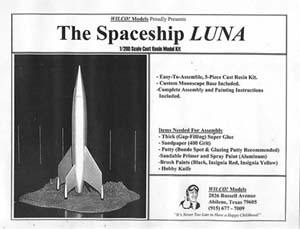SCALEWORLD By Richard Marmo | | As I was finishing up the July issue of Internet Modeler Richard contacted me with a brief note saying that his mother passed away. Our thoughts go out to him in this trying time. Ruby Claudine Marmo Fort Worth, Texas - Ruby Claudine Marmo, 97, a retired AT&T operator for 31 years, then 34 years on PBX boards, died Tuesday, June 25, 2002, at a local nursing home. Ruby Marmo was born May 15, 1905, in Belden, Mississippi, to Alfred and Roxie Stovall Wacaster. She was preceeded in death by her husband, Caesar "Jack" Sarafino Marmo in 1983. She was a member of Kings Highway Baptist Church. Survivors: Son, Richard Marmo of Fort Worth, Texas.
As all of you know (or should, since you're using one to read this),
the computer is a wonderful tool. When they work. They're also balky,
frustrating, maddingly logical (they could've been designed by a Vulcan)
and have a nasty tendency to quit working at the worst possible moment.
Murphe's Law must've been originated by a computer user!
Anyway, I've finally replaced my monitor and beaten the system into submission. Now all I have to do is catch up on everything that's been stacking up since the monitor went south. While it won't all be done in this issue, I'll at least make a dent. Now to work! Those of you with a penchant for science fiction models will love a couple of recent releases from WILCO! MODELS, 2826 Russell Avenue, Abilene, Texas 79605 (ph. #915-677-7009). Incidentally, they also have a new North American B-1 related item that I will be discussing in the near future. First up is a 1/200 scale resin kit of The Spaceship Luna from the movie Destination Moon. A simple model with only 5 pieces (6 if you count the nicely done Lunar surface base), it's a great choice for those of you with relatively little experience building resin kits. As always with WILCO! MODELS, the kit comes fully protected in a sturdy cardboard box. Quality is typical WILCO! MODELS. You get the ship's hull (fuselage?), two large fins, one small fin and a kickstand. Instructions are quite clear and should keep you out of trouble. As usual with resin kits, you'll have some parting lines to smooth down. Do be aware of the fact that the Luna has parting lines only on one side of the hull. What looks like parting lines on the opposite side…until you put on your glasses or OptiVisor…is actually molded-in ladder detail that runs almost the entire length of the hull. Make the mistake of sanding that down and your ship's occupants have no way to reach the surface! There's a fair amount of very thin flash on the fins and kickstand that you'll find very easy to remove. Finally, casting stubs are found on the ends of each part (except the base) that will need to be removed. Rather than make your cut flush with the top surface of each plug, I'd suggest that you remove the majority of each plug with a razor saw or carbide cutting wheel, then finish up with sandpaper. Cutting flush with the top surface leaves the parts shorter than they should be by the thickness of your saw blade. Holes on the hull and pins on the fins leave no doubt as to where the parts are to be located. However, you are going to rely heavily on your Mk.I eyeball computer to get each fin perpendicular to the hull. Nothing all that difficult about it, just take your time. Price of this little gem is only $25 plus $5 shipping. 
The second offering from WILCO! MODELS is a 1/144 scale model of The PAN-AM "Space Clipper". Essentially the Aurora 'Orion' kit that's been enhanced with added detail, this is a beaut. Comprised of only 4 pieces, it will make up into a dandy little model. There's also a basic 2-piece stand for you to mount it on, a length of wire to let you create the antennas and a small sheet of decals for the Pan-Am markings. Detail is excellent and so is the fit. You are going to have to deal with a substantial pouring stub (along with some moderately heavy flash) on the underside of the tail section. However, anyone used to resin construction shouldn't have any trouble handling it. As a matter of fact, those of you who do your own casting will probably wonder how WILCO! managed to cast that complex tail section as cleanly as they did. Granted, you'll have a little detail on the underside to restore, but I certainly don't mind that little problem. Despite having only 4 parts, I'd suggest that this "Space Clipper" is best suited for those with a reasonable amount of experience in resin construction. Price is $30 plus $5 shipping. If you're wondering which one to buy, consider this. Buy both (for a total of $55) and shipping is free. That way, if you have limited experience, you can build the Luna first before tackling the "Space Clipper". 
One of the latest…and long awaited…kits to appear from POLAR LIGHTS (https://www.polarlights.com ) is a repop of Voyage To The Bottom Of The Sea's Seaview submarine that was originally produced by Aurora in 1964/65. Molded in black styrene, the kit still has the 21 parts of the original. This includes an ocean floor base and nameplate. Parts are crisp and clean with no flash. Instructions have the usual retro appearance. As has now become a standard feature with many of POLAR LIGHTS latest releases, the boxtop has a small oval window in the lower righthand corner that allows you to see the color of the styrene. One out of every twelve kits are molded in white, which should be of interest to kit collectors. The Seaview carries a price tag of $17.99. (Be sure to check out the build-up in this month's issue as well. Ed.) 
Reference material on Soviet aircraft has always been hard to come by, though that is beginning to change. Nonetheless, looking for specific information on certain well-known jet fighters can still take on the appearance of a snipe hunt (If you've never been on a snipe hunt, you've missed an experience. Have no idea of what a snipe hunt is? Please accept my condolences.). The MiG-15 is one of those. Or was. The latest AEROFAX volume from MIDLAND PRESS, titled Mikoyan-Gurevich MiG-15 by Yefim Gordon, crams 160 pages with just about everything you'd want to know about that fabled MiG…and then some. Utilizing an 8" x 10", semi-stiff format, the glossy enamel stock does an excellent job of telling the MiG-15 story. Starting where it should, at the beginning, the MiG's genesis is thoroughly covered. While photos are b&w, you've got everything from the prototype (including shots of it with spin recovery rockets mounted under the wings) to ejection seat trainers and foreign production. Assembly line shots, in-flight refueling sequence shots, detail shots of gun installations. One page lists Soviet pilots who gained ace status with the MiG-15 as their mount. One lengthy chapter lists all nations that have operated the MiG, literally from A (Afghanistan) to Y (Yemen). Interestingly, that includes several being flown under civil registry in both Australia and the USA. Another chapter takes the form of Family Specification Tables that will enable you to tell one variant from the other. Eighteen pages of b&w drawings (mostly profiles) help illustrate family differences. Finally, the color section. You'll find seven pages of color photos, followed by another seven pages of color profiles that will be of particular interest to the modeler. As you would expect, most are bare metal with colored bands or other markings. Prefer camouflage? There are nine different profiles depicting camouflage schemes, including a two-seater in multi-tone desert camouflage circa 1963 and wearing Iraqi markings. All in all an excellent book that is distributed in North America by SPECIALTY PRESS (https://www.specialtypress.com ) and carries a very reasonable price of $29.95. You can order direct from SPECIALTY PRESS by visiting their website or calling them at 800-895-4585. Keep in mind that there will be a $4.95 shipping and handling fee per order. 
So much to talk about, so little time. Deadlines are the enemy of all writers! With four more books to review and an hour to deadline, the deadline wins. See you next month. | 








|











